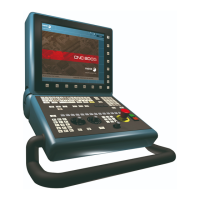CNC 8060
CNC 8065
26
·471·
(REF: 1807)
KINEMATICS CALIBRATION.
For the first time, this kinematics calibration allows for the kinematics offsets to be calculated
using various approximate data and, also, from time to time to correct any possible deviations
stemming from the day-to-day operations of the machine. After the calibration has been
completed, the CNC will display on the results page the kinematics parameters with the
original and calculated values, so the user can select which values to save. It also details
the issues encountered for the machining.
Subroutines associated with the kinematics calibration cycle.
The kinematics calibration cycle has two associated subroutines (KinCal_Begin.nc and
KinCal_End.nc), which the CNC executes before and after the cycle. The OEM can add initial
and/or final conditions to the calibration cycle using these subroutines. Also, the OEM can
customize the movement of the rotary axes in the subroutine Kin_G_Move.nc. Calling this
subroutine is defined in the GMOVE macro of the KinCal_Begin.nc subroutine, as shown
in the subroutine provided as an example.
Subroutine location.
The subroutines KinCal_Begin.nc and KinCal_End.nc, as well as the special subroutines
defined by the manufacturer, must be saved in the folder ..\Mtb\Sub. The subroutine
Kin_G_Move.nc must be saved in the folder ..\Fagor\Sub. All channels use the same
subroutines.
Requirements for the kinematics.
• The first three axes of the channel must be linear.
• The axes of the kinematics can be Hirth axes.
• The CNC allows for the calibration of all types of kinematics (parameter TYPE).
• The kinematics must be defined using values that are as close to the real ones as
possible, by taking the tool base as a reference.
• The rest position of the rotary axes must be 0º. The rest position is when the tool is
perpendicular to the work plane (parallel to the longitudinal axis).
Requirements for the probe.
To calibrate the kinematics, a probe calibrated by radius and length is required (the length
wear must be set to zero) and the parameter PROBEDELAY must be set for the axes
employed in the movement (the cycle can calculate this parameter). If the CNC cannot orient
the spindle (it cannot execute M19), the probe must be properly calibrated mechanically for
X and Y (without any deviations).
It is important that the length of the probe is measured using the same criteria as that used
to measure the length of the tool. Any small difference in measurement will directly affect
the proper calibration of the kinematics. One recommended way to calibrate the length of
the probe is to machine a flat section with a tool calibrated by length and then probe the
surface. The probe length is calculated using the formula:
(V.)A.TPOS.z + tool length = (V.)A.MEAS.Z + probe length

